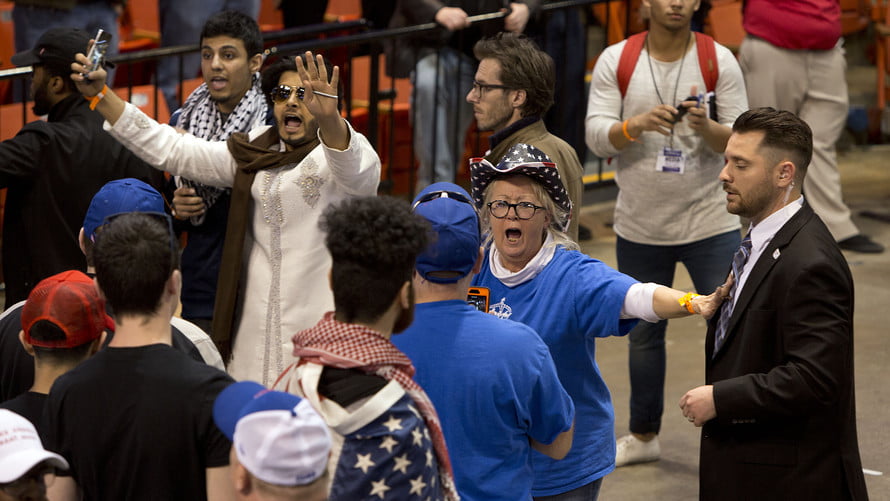

People clash at a Trump rally in Chicago in 2016.
Never before have Americans seemed so politically divided. You can hear the divisions in conversations at restaurants (particularly if you live in a swing state). You can see the divisions via protest signs on the evening news. You can look at the final outcome of the U.S. presidential election.
And sometimes, you can witness acrimony in the conversations on Facebook.FB, +1.02% But as so many of us have learned since the election, the so-called echo chamber or filter bubble effects of social media are strong. These refer to the idea that your social media newsfeeds are filled with people whose views agree with your own — and algorithms embedded into the systems often show you only those people’s posts. The algorithms are based on a variety of factors, including whose posts you “like” or share most often.
Is social media the political polarization culprit?
Journalists and researchers have blamed social media for much of the increasing political polarization over the past year — for example, New York magazine, Wired and CNN — and the role of social media in political divisiveness can’t be discounted. However, a new academic working paper published by the National Bureau of Economic Research (NBER) raises the question: Might we be giving too much credit to social media for our political polarization?
 Getty Images
Getty ImagesYes, especially as the division relates to older adults, notes Ezra Klein in his smart Vox story about the new research, “Something is breaking American politics, but it’s not social media,” published this week.
Using data from the American National Election Study, the NBER study authors (Stanford economists Levi Boxell and Matthew Gentzkow and Brown University economist Jesse Shapiro) analyzed nine measures of political polarization across age groups. They reported that the age group most likely to have grown more polarized in political beliefs in recent years was the over-65 set.
Other forces are at work
And they point out this is significant because this age group is the least likely to use social media on a regular basis. “Unless cross-group spillovers are very large or the effects of digital media vary greatly across groups, some other forces must explain the large increase in polarization among the groups least likely to use the internet,” the authors wrote.
In fact, in his interview with Klein, Gentzkow hypothesized that it was a combination of traditional media — talk radio and cable TV, specifically, which are more popular among older adults than younger adults — and structural issues like income inequality that truly may contribute to political polarization.
“Whatever is tearing our politics apart is deeper and more universal than the digital filter bubbles that get so much attention — and it seems to be most powerful among the people least likely to get their news from social media,” Klein wrote.
Shayla Stern has spent a career in digital media journalism and content marketing strategy at organizations including washingtonpost.com, Edmunds.com, Cars.com and Fast Horse and as a media professor at the University of Minnesota and DePaul University. She has a Ph.D. in mass communication from the University of Iowa and has published extensive research on social media and gender. Based in St. Paul, Shayla can be reached by email at [email protected].
This article is reprinted by permission from NextAvenue.org, © 2017 Twin Cities Public Television, Inc. All rights reserved.
[“Source-marketwatch”]

